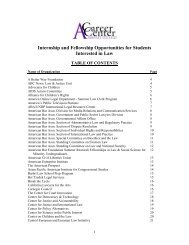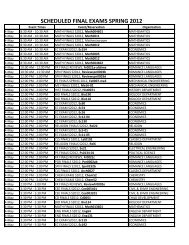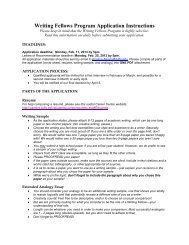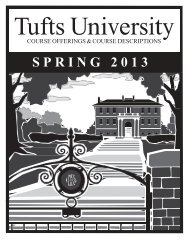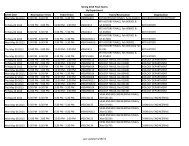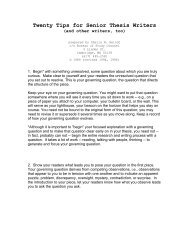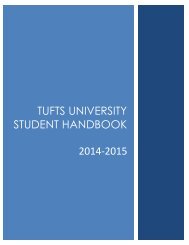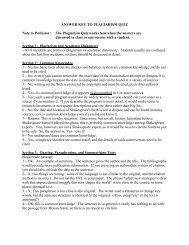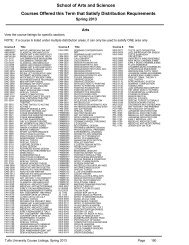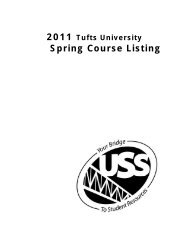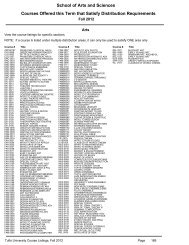2013â2014 The Bulletin - USS at Tufts - Tufts University
2013â2014 The Bulletin - USS at Tufts - Tufts University
2013â2014 The Bulletin - USS at Tufts - Tufts University
Create successful ePaper yourself
Turn your PDF publications into a flip-book with our unique Google optimized e-Paper software.
BioEngineering ><br />
BioEngineering CertiFIc<strong>at</strong>e Program ><br />
Biology ><br />
<strong>The</strong> certific<strong>at</strong>e requires four courses.<br />
One bioengineering introductory course:<br />
Biomedical Engineering 250 Introduction to Biomedical<br />
Engineering I (focus on biomedical engineering and<br />
instrument<strong>at</strong>ion) or<br />
Biomedical Engineering 162 Molecular Biotechnology<br />
(focus on molecular biology and engineering aspects of<br />
biotechnology)<br />
One physiology course (choose five modules):<br />
Biomedical Engineering 121/122 Engineering Challenges<br />
in Physiology I and II (modules include general, neurology/<br />
nose, skeletal/bone, respir<strong>at</strong>ory, cardiovascular, renal,<br />
gastrointestinal, endocrine, eye, dental)<br />
One engineering elective in biomedical<br />
instrument<strong>at</strong>ion, biomedical optics, biom<strong>at</strong>erials,<br />
biotechnology, or tissue engineering<br />
One capstone course:<br />
Biomedical Engineering 100 Design of Medical<br />
Instrument<strong>at</strong>ion or<br />
Biomedical Engineering 164 Biom<strong>at</strong>erials and Tissue<br />
Engineering<br />
For more detailed inform<strong>at</strong>ion, please visit the<br />
website http://engineering.tufts.edu/bme/.<br />
Bioengineering Certific<strong>at</strong>e<br />
Program<br />
Faculty ADVISORS:<br />
Professor Sergio Fantini, Biomedical Engineering<br />
Professor David L. Kaplan, Biomedical Engineering /<br />
Chemical and Biological Engineering<br />
<strong>The</strong> booming biomedical industry demands skilled<br />
professionals whose expertise can cross traditional<br />
boundaries of science and engineering. Companies<br />
are seeking electrical engineers who understand the<br />
medical uses of diagnostic imaging instrument<strong>at</strong>ion,<br />
biotechnology professionals with training in<br />
tissue engineering to develop tissue implants, and<br />
mechanical engineers who are well-versed in<br />
biom<strong>at</strong>erials to design artificial joints.<br />
<strong>The</strong> certific<strong>at</strong>e in Bioengineering addresses this<br />
need through a highly interdisciplinary course of<br />
study th<strong>at</strong> allows students to focus on biomedical<br />
instrument<strong>at</strong>ion, biomedical optics, biom<strong>at</strong>erials/<br />
biotechnology and tissue engineering or other<br />
rel<strong>at</strong>ed areas of study. Courses are taught by faculty<br />
in engineering as well as experienced clinical<br />
professionals from <strong>Tufts</strong>’ world-renowned health<br />
science schools.<br />
<strong>The</strong> program is open to students with <strong>at</strong> least a<br />
bachelor’s degree in engineering, science, or health<br />
science.<br />
With this certific<strong>at</strong>e engineers can launch careers<br />
in biomedical instrument<strong>at</strong>ion design. Clinical<br />
practitioners and technicians can shift careers to<br />
biomedical equipment sales. It is also a useful<br />
technology complement for executives, medical<br />
professionals, and policy makers interested in the<br />
applic<strong>at</strong>ion of technology to the medical, business<br />
or legal profession.<br />
<strong>The</strong> certific<strong>at</strong>e requires the completion of four<br />
courses.<br />
For more inform<strong>at</strong>ion, contact the Program<br />
Administr<strong>at</strong>or, Angela Foss, <strong>at</strong> 617-627-2320, or<br />
visit http://gradstudy.tufts.edu/certific<strong>at</strong>es.<br />
Biology<br />
Associ<strong>at</strong>e Professor Juliet Fuhrman, Chair; Immunology<br />
and parasitic diseases<br />
Professor Joanne E. Berger-Sweeney, Dean, School of Arts<br />
& Sciences; Neurobiology<br />
Professor Frances Sze-Ling Chew, Ecology, plant-insect<br />
interactions<br />
Professor David E. Cochrane, Cell physiology, inflamm<strong>at</strong>ion<br />
Professor Susan G. Ernst, Developmental biology<br />
Professor Michael Levin, Vannevar Bush Professor and<br />
Director of <strong>Tufts</strong> Center for Regener<strong>at</strong>ive and Developmental<br />
Biology, morphological and behavioral inform<strong>at</strong>ion<br />
processing living systems<br />
Professor Sara M. Lewis, Evolutionary and behavioral<br />
ecology<br />
Professor Sergei Mirkin, White Family Chair in Biology,<br />
Molecular genetics<br />
Professor Colin M. Orians, Ecology, plant-herbivoreenvironment<br />
interactions<br />
Professor Jan A. Pechenik, Invertebr<strong>at</strong>e zoology, marine<br />
invertebr<strong>at</strong>e reproduction<br />
Professor J. Michael Reed, Conserv<strong>at</strong>ion biology,<br />
ornithology, behavior<br />
Professor L. Michael Romero, Physiological endocrinology,<br />
physiology of stress<br />
Professor Barry A. Trimmer, Henry Bromfield Pearson<br />
Professor of N<strong>at</strong>ural Sciences; Neurotransmitters and receptors<br />
in insects, intracellular signals<br />
110



